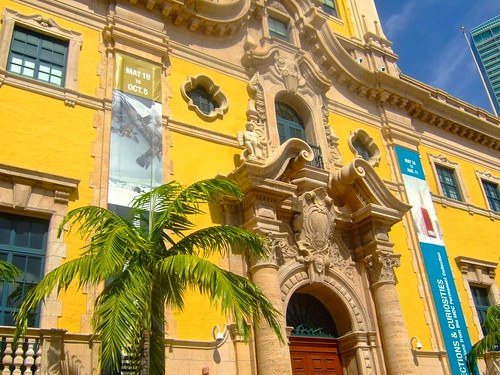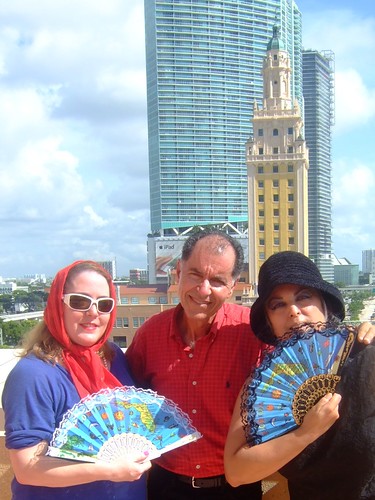 |
| The Freedom Tower in Miami, Florida. |
Earlier this summer, I had the honor of receiving an assignment from The American Latino Heritage Fund to participate in a road trip celebrating America’s Hispanic roots. Because of my caregiving situation, I was not actually able to travel, but my trusted fellow explorer, Tallahassee-based Bohemian Babushka, took to the road with the itinerary I had planned highlighting national parks and historic sites relevant to Florida’s Spanish history. I participated remotely and was able to report on the Freedom Tower in Miami.
The American Latino Heritage Fund is a branch of the National Park Foundation, which is the charity for the National Park Service. Six bloggers were chosen to travel across different sections of the country.
Since I had already done Trail of the Pirates, this road trip seemed like a natural follow-up, which is quite timely – in 2013, Florida will celebrate its 500th anniversary, marking Ponce de León’s sighting of the peninsula in 1513.
THE FREEDOM TOWER
 |
| A gentle lady among steely giants. |
The Freedom Tower is listed in the National Register of Historic Places and is also a National Historic Landmark. The building today is overshadowed by modernity: gargantuan glass condos and the American Airlines arena flank its ornate facade. But this building echoes a distant time in a far away land – built in 1925 to house the Miami News, its design was inspired by the Giralda Tower, which was part of a 13th century Muslim mosque that would later become the main cathedral in Sevilla, Spain.
Miami was no stranger to Spanish influence since Columbus’ first voyage to America. In 1513, Ponce de León sailed into Biscayne Bay. Pedro Menéndez de Avilés, the founder of St. Augustine, set foot here in 1566, while on a voyage to find his shipwrecked son.
The Miami River was once the site of a Catholic mission located less than a mile from where the Freedom Tower stands today. In 1567, a Jesuit brother transported Tequesta Indians who lived by the Miami River to the Sevilla cathedral where they were baptized.
But fast forward to the 20th century: in the 1960s, the building became the Ellis Island of the South for many Cuban refugees fleeing the island’s Marxist regime. Cuban immigrants flocked to the resettlement center for processing and support. Many Cubans lived just west of the Miami River in a neighborhood called Riverside -- a section of today’s Little Havana. The refugees would visit the tower to collect food, cash, clothing and other essentials.
Miami Dade College owns the tower today. Its spacious mezzanine serves as an art gallery and reception space.
The Freedom Tower is an icon of America’s Spanish heritage, not only for its design, but because it marks a significant moment in the country’s continual history of immigration.
And poised like a gentle lady among steely giants, she reminds us of the drive to explore and the desire for freedom. It is fitting that another icon of Latin American culture – Celia Cruz, the world-renowned salsa singer – held her public memorial service here for South Floridians. Thousands passed through the tower’s majestic door that day in 2003 to honor the sassy songstress.
 |
| Yours truly, Dr. Paul George and Bohemian Babushka. |
INTERVIEW WITH DR. PAUL GEORGE
THE FLORIDA LATINO HERITAGE ITINERARY
Bohemian Babushka traveled all over Florida. Below are points of interest, should you desire to repeat the same itinerary.
Florida's Spanish history is rich though and due to time constraints, we omitted the Treasure Coast, Biscayne Bay National Park and Dry Tortugas National Park, as well as other Gulf Coast sites.
No body of water surrounding the state was left untouched by Spanish influence and the Gulf Stream off the east coast aided navigation for the Spanish Main. Galleons, laden with treasure, shipwrecked the east coast in 1715 but the most famous wreck, the Atocha, is just south of Key West. On the gulf coast, stories abound, including the voyages of explorers Hernando de Soto and Pánfilo de Nárvaez, who battled with Calusa Indians in the 15th and 16th centuries.
A lesser-known Spaniard, Hernando De Escalante de Fontaneda, shipwrecked on the gulf coast at the age of 13 and lived with native tribes for 17 years until Pedro Menéndez de Avilés rescued him around 1566. He eventually returned to Spain and wrote a memoir of his experiences in the New World.
Next year, Babushka and I plan on covering the Florida quincentenary with a richly detailed documentary about Florida’s Spanish heritage, starting out with the very first Christmas at Mission San Luis in Tallahassee.
Learn more about the quincentenary at Viva Florida.
LINKS TO HISTORIC SITES
Read a recap of the journey at Bohemian Babushka.
De Soto National Memorial
De Soto Winter Encampment
Museum of Florida
Mission San Luis
Castillo De San Marcos
Fort Matanzas
Ybor City Museum
Freedom Tower
The Florida segment of the American Latino Heritage Fund Road Trip was generously supported by VISIT FLORIDA, Verizon Wireless and GM Diversity/GM Southeast, as well as the following convention and visitors bureaus: Charlotte Harbor, Bradenton Area, Tampa Bay, Visit Tallahassee and Florida’s Historic Coast.
Special thanks to historian and professor Dr. Paul George for his time and to Alfonso Guerra for assisting in the Freedom Tower interview. R. Gabrielle Reed loaned beautiful period costumes and the Florida Humanities Council, as well as actor Chaz Mena, contributed to research. Manny Ruiz of Hispanicize was one of the project organizers.

